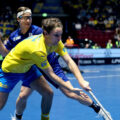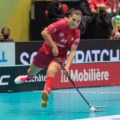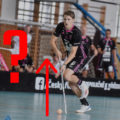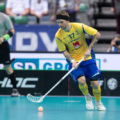Powerplay occurs when a team gets a 2- or 5-min penalty after a foul and should be a golden opportunity to score. After all, the top teams in the world score around 50-70% of their powerplays and have the ability to convert the numerical advantage to a lot of goals.
But for us mere mortals, this is far from easy.
In one of my previous articles, I talked about free balls and how that often goes very wrong during my own training sessions – and now I want to start with an example of a dramatic powerplay:
After two warnings, that one crazy guy in your opponent’s team slashes your stick for the hundredth time this match. He gets a 2-min penalty for slashing and is sent to the side of the field. Your team plays powerplay and gets the chance to hunt for a goal, but it’s not going well. Not a single pass arrives, the ball is lost several times and it takes a long time to recover ball possession. The worst? The biggest chance of the powerplay … is for your opponents – while they have one man less!

Sounds familiar? Or at least not entirely outside the realm of possibilities?
Then this is the article you are looking for.
In this introductory article, I will explain the essentials of a powerplay. I will discuss the different positions in the field, their roles, what qualities you are looking for in players for each position, how the different positions interact and a couple of simple patterns that your team can take advantage of right away.
I also mention things like the slot, the ball side and help side of the field and the height of defense. If you are not yet familiar with these terms, I advise you to first read this article about defending in the dice five, the 2-1-2 formation.
Ready? Let’s go!
Index
Introduction
Powerplay comes in different shapes and sizes. In the example above, it is a 5-vs-4 situation, where only one player has a time penalty, but in floorball, it can also happen that 5-vs-3 is played, or 6-vs-5, 6-vs-4 and in emergency situations sometimes even 6-vs-3.
For simplicity’s sake, we’ll focus on a standard 5-vs-4 powerplay, the most common of numerical advantage situations.
In the picture below I have drawn the default positioning of the powerplay. In this case, the defensive team plays in a diamond 1-2-1 up to about 50% of the field. We are the attacking party and have the ball on our own half. We are in a kind of 1-3-1 / 1-2-1-1 formation.

Disclaimer: The goal of this article is not to tell you how you have to build your powerplay but to give you advice on how you can build it. There are many variations in which you can position a team for powerplay but since this is the first article I choose to keep things simple.
The Point
I review the positions of all players, starting with the Point (player #1). This is the last man.
Qualities you want him to possess:
- Good passer
- (Good distance shot)
His job is to move the ball quickly from left to right across the field so that the opponent is pulled out of position, in order for us to work towards a great shooting chance. Less important is if he has a good distance shot. It’s a welcome addition but less important than somehow who can hold the ball and passes accurately and fast. The important thing here is, and this is more or less general advice but applies to powerplay even more: know your next action before you get the ball.
In the article about the Royal Road, I explained earlier how important it is to move the ball. By means of quick passes across the width of the pitch, you ensure that the opponent’s goalkeeper has to move each time. With a shot, he is, therefore, more likely to be out of position and won’t be able to see the ball coming. Read the article here.
Left Wing & Right Wing
There are two players on the sides of the pitch who can also pass well, but perhaps even more importantly, who have a good (direct) shot. So we’re looking at these qualities:
- Good passer
- Good shot (wrist or slap)
- Lefty on the right side
- Righty on the left side
If the Point manages to play the ball to LW or RW fast enough, and the goalkeeper is too slow in moving, they can try a direct shot. However, this is only possible if the pass is good: fast and hard, but over the ground and without a spin effect.
What often turns out to be a successful tactic is the following:
- Point plays back and forth to LW and RW. With each pass, the opponent will move a bit further towards the ball side.
- At some point, Point passes the ball to RW or LW who can shoot directly without an opponent being in the path of the shot.
There is a good chance that the goalkeeper is still in the other corner of the goal, so there is a fair of scoring a goal.
Note that while we’re already working on a big shooting opportunity, we’re not even using all of our players yet! An important point here is that LW and RW should always be a threat to the goal.
Are you standing with your back towards the goal?
Then your opponent automatically knows that you can never shoot at goal in one go, so there is little threat from your side. However, if you are ready to shoot directly – stick firmly grabbed, having an open stance towards the goal and are aware of where the goalkeeper is sitting – the opponent will have to respond to you as soon as the ball goes your way performing a fake shot also works very well in this regard: you do if you are going to take a devastating shot at goal, but eventually decide to return the ball to the Point.
The opponent will have to adapt to the new situation after every pass with especially their most forward player. Also, their wing players have to make many meters if they want to catch up with the passing. So don’t be afraid to be patient, because that’s the only way to exhaust your opponent until he is no longer in the lane of the shot.
Time to bring our fourth player in the equation.
The Slot Guy

Slot, not sloth! Not you again …
Naming the Point and the two Wings was fairly easy. I tried to come up with a cool name for the man in the middle but this was tougher than I anticipated … so Slot Guy it is.
Slot Guy is the most dangerous player on the field during a powerplay. Why?
[ppp_non_patron_only]As much as we love floorball, we dedicate a lot of time and money to the FloorballToday project (more info here). That's why we ask you for a small monthly donation. By clicking the button below you can become one of our supporters and read the rest of the article. Thanks a lot! Already a patron? Then here is where you can login. [/ppp_non_patron_only][ppp_patron_only level="6" silent="no"][ppp_patron_only level=”6″ silent=”no”]
Let me share a quote of myself from the 2-1-2 article:
“The slot is one of the most important parts of the field. If the opponent has the ball in this area, there is a higher chance that they will score because they are close to the goal.”
This means that if you manage to get the ball in the slot, you will have a greater chance of scoring.
But the problem is … your opponent knows this as well (since they will be avid readers of the FloorballToday content).
That means that this player will probably have a hard time getting the ball, if at all. He is probably the most guarded player in the field.
For a good example of the Slot Guy we can look at Kim Nilsson’s goal in the SWE vs FIN finals of WFC2016 (scroll forward to 24 seconds):
It’s definitely not easy to score from this positioning and a big part of his role is to draw the attention of defenders.
But don’t worry, the right qualities will make his life much easier:
- Can shoot fast with little space.
- Efficient in his touches.
- Physical.
So how do we incorporate our Slot Guy into our game? Let’s take a look again at our field:

The situation is still that our Point, LW and RW pass the ball back and forth. Every time LW gets the ball to the left of the field, opponent C puts light pressure on the ball, after which LW bounces the ball back to the Point. Defender B does exactly the same in the case RW gets the ball played on the left side of the field.
If player B or C moves out too far now, there is space behind him to play to Slot Guy. If this is the case, you can give a pass with a high chance of scoring a goal, provided Slot Guy is ready for the direct shot.
One step further
However, if B and C have read the 2-1-2 article correctly, they know not to step too far out of the slot.
This means that our wings have more room on the side, but the opponent should take this for granted (after all, they play box play and have little choice). The task of Slot Guy, in this case, is that of a jammer. If he can keep two or even three players busy on his own, simply by walking back and forth in the slot, it means that our fellow players can play in an even more favorable numerical advantage situation.

Here you see how the opponent (in green) must move when we pass the ball back and forth between players the Point and the Wings.
It is important to realize that the ball has to be in motion a lot, as this forces the opponent to be in motion as well. The more the opponent has to move, the greater the chance we have of finding space between their players for a cross to Slot Guy or for a direct shot by our Wings or the Point.
Johnny Deep
In the explanation so far one player has not been mentioned: our deepest player. He is near the goal, although it is not an ‘obligation’ to stand here.
Let’s call him Johnny Deep because he will be mostly our deepest player. These are the qualities we’re looking for:
- Quick reflexes
- Able to score in chaotic situations and rebounds
Now that the “build-up” part of our powerplay is laid out, we can slowly move forward towards the opponent’s goal.
If our Slot Guy behaves as in the example above, there is a high chance that he won’t get the ball because it is too full of opponents in the slot. Our Wings therefore not only have the option to bounce back to the Point or to go for the direct shot but also to move the ball forward. There is a lot of space at the boarding.

In the picture above a large red area is drawn: the slot. If, as the attacker, you receive the ball in this area, you can expect to have an opponent on your neck within a second. Conversely, if you are the defending team and the opponent remains outside the slot, you can afford to ‘leave him alone’.
That leaves us with more options. Just have a look at the GIF below:

The attentive reader has already seen that Johnny Deep was initially near the goal but is now in the corner. For Johnny Deep it’s a matter of timing: when do you leave for the corner? He sees the passes between our Wings and the Point and can thus estimate when for one of the Wings there is the possibility to walk up to the forward via the boarding or to enter the direct pass into the corner.
In the GIF you can see how the game starts again at the point at the back, which plays the ball twice wide before Right Wing decides to play the ball into the corner. What is noticeable is that player Left Wing makes himself immediately playable behind the goal along, so Johnny Deep immediately has two safe passing options: back via the boarding to Right Wing or behind the goal along to Left Wing. Always try to have two safe passing options in powerplay!
A couple of basic tips
Basically, this explains the basic rules of powerplay. Some tips:
- Keep the ball in motion as much as possible, to force your opponent to move along. This creates space for a pass, running action or direct shot.
- A player can stand somewhere without having to receive the ball, as #4 in our example. His primary goal is to distract the opponent.
- Make sure that there are always at least two safe passes possible. If you don’t have the ball yourself, this may mean that you have to make yourself playable as quickly as possible, as player 3 in the GIF does by passing behind the goal.
Summary
Using drawn and real examples I tried to give you an explanation of the basics of playing powerplay.
In offense, it remains important to always have safe options to apply to. In addition, players should have a threat to the goal.
Now we have introduced our players, I will dive into actual scoring in my next article. I will discuss some interesting patterns to use to come to a (dangerous) shot.
If you have any questions or suggestions about this, please let me know! I may then be able to discuss it directly in the article. If you have any questions about the current article, you can of course also contact me via social media, Patreon or the website.
[/ppp_patron_only]













No Comments
Leave a comment Cancel